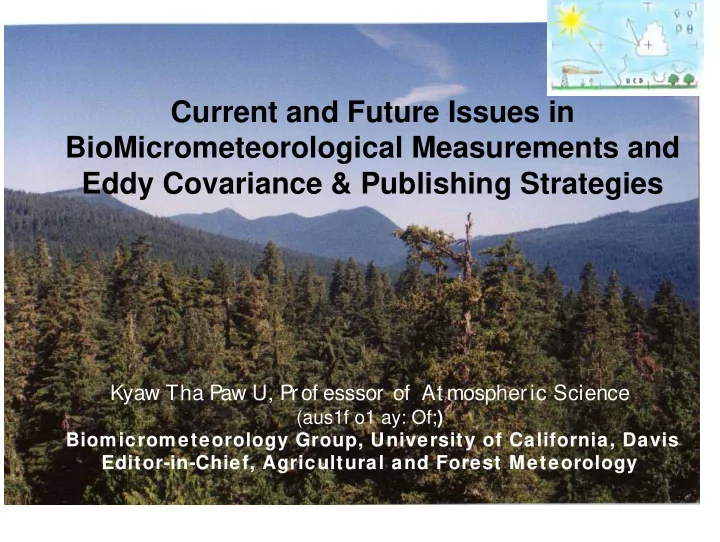

Current and Future Issues in BioMicrometeorological Measurements and Eddy Covariance & Publishing Strategies Kyaw Tha Paw U, Prof esssor of At mospheric Science (aus1f o1 ay: Of; ) Biomicrometeorology Biomicrometeorology Group, University of California, Davis Group, University of California, Davis Editor-in-Chief, Agricultural and Forest Meteorology Editor-in-Chief, Agricultural and Forest Meteorology
The scale of physiological ecology (Osmond) Climatic Synoptic Regional Planetary Boundary Layer Turbulence Diffusion Diffusion
The scale of physiological ecology (Osmond) Climatic Synoptic Regional Planetary Boundary Layer Biomicrometeorology Turbulence automatically integrates to field-regional scales Diffusion Diffusion
Common Current Systems: Eddy Covariance Above, Crude Mean Profile Within Canopy for Carbon and Water Storage
MASS BALANCE TO MEASURE CARBON, WATER EXCHANGE
Common Current Systems: Eddy Covariance Above, Crude Mean Profile Within Canopy for Carbon and Water Storage COSTS (US DOLLARS) 2,000-20,000 SONIC ANEMOMETER 10,000-15,000 IRGA FOR CO 2 2,000-17,000 FOR PROFILER INACCURACY 10-20% UNDER TURBULENT CONDITIONS 20-100% UNDER LOW TURBULENCE
Overstory (70 m) Eddy-Covariance System Eddy Covariance Above LOW TURBULENCE: (Normally at Night) Carbon Emission Never Reaches Canopy Top Carbon Advects Below Estimate by Temperature, Moisture. Etc. Equation Derived when Turbulence High (as measured by u*) Estimate by Chambers over Soil, Plant Elements Estimate by Direct Advection Measurements
FUTURE DEVELOPMENTS Smaller, More Sensitive Sonic Anemometers More Accurate Understory/Soil Exchange Less Expensive, Improved Mean Advection Turbulent Advection Measurements Possible Less Expensive Fast Response IRGAs or other Gas Sensors Improved Mean Advection Turbulent Advection Measurements Possible Networking of Sensors Possible to Make Both Eddy-Covariance and Advection Measurements Possible
FUTURE DEVELOPMENTS Process-Based Models Become more Sophisticated Improvements in Parameter Measurements Improve Process-Based Results Models Used for Data Filling Empirical Models Become more Sophisticated and are used for Data Filling
PUBLISHING GUIDELINES PUBLISH NEW/NOVEL MATERIAL--NEW CONCEPTUAL FRAMEWORKS THEORY EXPERIMENTAL TECHNIQUES NEW SITES WITH NEW RESULTS (DIFFERENT CONTINENT, CLIMATE, SOIL, ECOSYSTEM TYPE) NEW RESULTS (DIFFERENT ECOSYSTEM RESPONSE) LEVEL OF NOVELTY IMPORTANT
PUBLISHING GUIDELINES OUTLINE-ORGANIZATION OF PAPER ABSTRACT INTRODUCTION & LITERATURE REVIEW MATERIALS AND METHODS RESULTS & DISCUSSION CONCLUSIONS ACKNOWLEDGEMENTS REFERENCES/BIBLIOGRAPHY
PUBLISHING GUIDELINES OUTLINE-ORGANIZATION OF PAPER Outline the paper by including the major methods
PUBLISHING GUIDELINES OUTLINE-ORGANIZATION OF PAPER ABSTRACT-- Briefly Explain main points of the manuscript, and how they are important to the topic/subject
PUBLISHING GUIDELINES OUTLINE-ORGANIZATION OF PAPER ABSTRACT INTRODUCTION & LITERATURE REVIEW In a few pages, summarize what has been done field that is relevant to your manuscript--please don’t make this section too long--and highlight what is NEW about your study
PUBLISHING GUIDELINES OUTLINE-ORGANIZATION OF PAPER ABSTRACT INTRODUCTION & LITERATURE REVIEW MATERIALS AND METHODS Describe the experiment well enough for someone else to replicate the experiment; describe the field site sufficiently well (location, canopy height, fetch, altitude above sea level, species, leaf area index, history of ecosystem,etc.) 2-5 Pages
PUBLISHING GUIDELINES OUTLINE-ORGANIZATION OF PAPER ABSTRACT INTRODUCTION & LITERATURE REVIEW MATERIALS AND METHODS Describe the experiment well enough For someone else to replicate the experiment; Describe Sensor TYPES LOCATION of sensors, DATA used (Dates, Times), CALIBRATION procedures for sensors (Dates, Frequencies) Data QUALITY CONTROL/ASSURANCE
PUBLISHING GUIDELINES OUTLINE-ORGANIZATION OF PAPER ABSTRACT INTRODUCTION & LITERATURE REVIEW MATERIALS AND METHODS RESULTS & DISCUSSION DESCRIBE THE RESULTS, AND IF THE RESULTS MATCH PREVIOUS STUDIES 5-15 PAGES
PUBLISHING GUIDELINES OUTLINE-ORGANIZATION OF PAPER ABSTRACT INTRODUCTION & LITERATURE REVIEW MATERIALS AND METHODS RESULTS & DISCUSSION CONCLUSIONS (One Paragraph or Two) POINT OUT THE MOST RELEVANT FINDINGS BASED ON THE REST OF THE PAPER, CONCLUDING REMARKS ESTABLISHING IMPORTANCE OF PAPER, NOVELTY OF RESULTS
PUBLISHING GUIDELINES OUTLINE-ORGANIZATION OF PAPER ABSTRACT INTRODUCTION & LITERATURE REVIEW MATERIALS AND METHODS RESULTS & DISCUSSION CONCLUSIONS ACKNOWLEDGEMENTS LIST PEOPLE WHO HELPED WHO DIDN’T DO ENOUGH TO BE CO-AUTHORS LIST GRANTS WHICH CONTRIBUTED
PUBLISHING GUIDELINES OUTLINE-ORGANIZATION OF PAPER ABSTRACT INTRODUCTION & LITERATURE REVIEW MATERIALS AND METHODS RESULTS & DISCUSSION CONCLUSIONS ACKNOWLEDGEMENTS REFERENCES/BIBLIOGRAPHY LIST APPROPRIATE REFERENCES FOR A CITATION: EARLIEST PUBLICATION ON CONCEPT IMPORTANT MODIFICATION OF CONCEPT LATEST MODIFICATION OF CONCEPT
PUBLISHING GUIDELINES OUTLINE-ORGANIZATION OF PAPER ABSTRACT INTRODUCTION & LITERATURE REVIEW MATERIALS AND METHODS RESULTS & DISCUSSION CONCLUSIONS ACKNOWLEDGEMENTS REFERENCES/BIBLIOGRAPHY LIST APPROPRIATE REFERENCES FOR A CITATION: DON’T CITE REFERENCES FOR VERY COMMON TECHNIQUES SUCH AS EDDY-COVARIANCE. SOIL CHAMBERS, ETC. OR IF YOU DO, CITE EARLIEST REFERENCES EXAMPLE: (SWINBANK 1951)
PUBLISHING GUIDELINES IF YOU ARE NOT A NATIVE ENGLISH/AMERICAN WRITER: GIVE TO A FLUENT ENGLISH/AMERICAN SPEAKER- WRITER TO GO OVER PAPER, PAGE, PARAGRAPH AND SENTENCE STRUCTURE
This research was supported by the Office of Science (BER), US Department of Energy, through the Western Regional Center of the National Institute for Global Environmental Change under Cooperative Agreement NO. DE-FC03-90ER61010. The WRCCRF is operated under joint sponsorship of the University of Washington and the USDA Forest Service/PNW Station and we acknowledge both for significant support. Any opinions, findings and conclusions or recommendations expressed herein are those of the authors and do not necessarily reflect the view of the DOE.
Recommend
More recommend